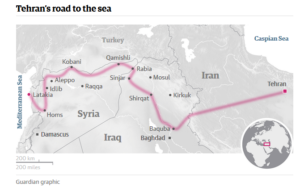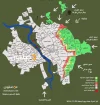Analysis: Iraqi Popular Mobilization Forces in Iran’s game plan
By
Amir Toumaj | November 23rd, 2016 |
[email protected] |
@AmirToumaj
As Iraqi Popular Mobilization Forces (PMF) have been
closing in on Tal Afar, a town 33 miles west of Mosul, alongside the western Mosul axis, the organization’s top commanders have openly discussed their post-Islamic State plans to secure the border with Syria and push into the country. These senior militia commanders are closely affiliated and coordinated with Iran.
The spokesman of Iranian-backed Harakat al Nujaba
vowed on Nov. 18 that the PMF, as “one of Iraq’s security institutions,” was ready to pursue the Islamic State into Syria per the request of the Syrian government and the approval of the Iraqi government and parliament.
“It makes no difference whether we fight terrorism inside Iraq’s soil or outside of it,” the spokesman said. An offshoot of Asaib Ahl al Haq, Harakat al Nujaba was formed to fight in the Syrian civil war on the side of the Assad regime and already has forces deployed to Aleppo.
On Nov. 16, Iranian-backed Badr Organization leader Hadi al Ameri
told the press in Baghdad that Damascus had requested the PMF to deploy to Syria following the expulsion of the Islamic State from Iraq, and that the PMF would establish security by the border area, according to statements carried in
Al Waght. Iraq’s Prime Minister Hayder al Abadi had echoed those two points one day earlier, announcing to the media that Baghdad and Damascus were coordinated for exerting border security.
The PMF is a 120,000-strong army with at least 80,000
fighting under the banners of Iranian-backed militias. It is a valuable pool of recruits and fighters. The PMF’s planned moves to establish presence by the border with Syria and shift into the war there following the Islamic State’s defeat in Iraq reflect important components of Tehran’s long-term strategies in Iraq and Syria.
There are
discussions in Western policy circles about Iran’s game plan to build a land corridor from Iraq to Lebanon with its proxies, anchoring Iranian-backed forces in the region. Tehran, however, already exercises freedom of movement to the Mediterranean via its air bridge to Syria and has moved materiel and manpower to the Levant with impressive results despite sanctions and through two wars in the Middle East’s heartland. Iran has prevented Bashar al Assad’s fall and has turned around the civil war in Syria. Tehran has
stockpiled more than 100,000 rockets in Lebanon. Islamic Revolutionary Guard Corps (IRGC) commanders have been
bragging about
extending their sphere of influence to the Mediterranean for the past three years.
The hypothesized Iranian land corridor. Credit: The Guardian
Re-establishing a viable land corridor through Syrian territory would carry significant costs. During the early phases of the war, Iran used supply routes from Baghdad to Damascus before oppositions forces interdicted all routes by the fall of 2012,
as discussed by Will Fulton, formerly of the
American Enterprise Institute. Turkish regular forces and Turkish-backed rebels are now expanding in northern Syria, and other hostile groups control territory between eastern and western Syria and in the northern countryside. Although the PMF has left the option of pushing into eastern Syria on the table, and Akram al Kabi, head of Harakat al Nujaba, has
gone as far as calling for marching into the Islamic State’s stronghold of Raqqa, the Iraqi militias would face difficult challenges advancing through and consolidating non-Shiite territory, especially without reliable air support.
Tehran’s immediate priority in Syria is to
achieve military victory in Aleppo. That would dim the opposition’s chances of taking urban territory and threatening regime positions. Iran has been
instrumental in laying siege to the rebel-held part of the city. This operation, which would not have been possible without Russian intervention, has
consumed significant Iranian and proxy blood and treasure in the past year. Victory in Aleppo is near,
said Hashem al Heydari, the Hezbollah Brigades Secretary-General and PMF official, to an audience of Iranian Basij paramilitary in Bojnourd, Iran’s North Khorasan province, on Nov. 22. Conquering the city and continuing gains in Damascus and Hama areas would contribute to stabilizing the regime, translating into leverage for future negotiations.
Even if negotiations are not fruitful, the pro-regime coalition could still win by eliminating the option of overthrow and consolidating control over “essential” Syria that stretches from Damascus to the Mediterranean. As long as Iran can find recruits, it can sustain its international proxy model at a low-level conflict that does not pose existential threats to the Syrian regime.
The pro-regime coalition, however, is still vulnerable should a major foreign power decide to ally with Turkish forces,
activate the southern front, and reinvigorate rebels in the north, as discussed in depth by Tony Badran in
The Cipher Brief. Tehran is aware of its vulnerabilities in Syria; the Iranian leadership is
strategically risk-averse and would not jeopardize hard-fought gains for the glory of territorial conquest.
In Iraq, the PMF seeks to cement itself as a fabric of the state. The Iraqi Prime Minister’s order this past year to
establish the PMF as an independent military institution in an effort to exercise more control already legitimizes their continued existence beyond the 2014 mandate based on the
fatwa of Grand Ayatollah Ali Sistani to drive the Islamic State from Iraq. That threat is prescient as long as the group controls Raqqa and has a presence in Iraq. Unless Iraq can train between 50,000 – 100,000 troops, which it does not appear to have the will nor means to effectively do so, the PMF can make a strong case that its mandate is unfulfilled and that it fills security voids, pushing back against
calls from certain quarters for dissolution and disarming.
The PMF’s mentors, the IRGC in Iran and Hezbollah in Lebanon, have reinterpreted their respective
raison d’etre of guarding the revolution and resisting Israel – both entities have transformed over the course of decades into dominant military institutions with political, economic, and cultural influence. The PMF has similar aspirations to ascend in Iraq, and its key leaders who are beholden to Iran see themselves as part of the “Axis of Resistance” led by the Islamic Republic.
Amir Toumaj is a Research Analyst at Foundation for Defense of Democracies.





